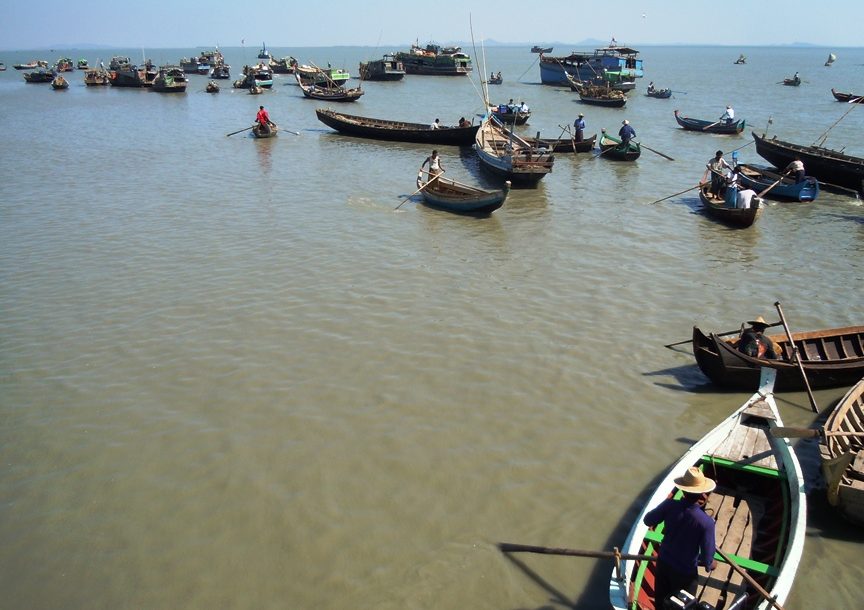This column was published at The Myanmar Times on Monday, 8 June 2015
The immediate Rohingya migration crisis – of gangster criminality, vessels set adrift, people starving and bodies exhumed – is galvanising action among those who can’t accept such evil. Efforts to avert these humanitarian tragedies must be supported.
But we cannot ignore the source of the problem right here in Myanmar, where northern Rakhine State has become inhospitable to its Muslim population. It does not help that Rakhine State remains the second-poorest administrative division of Myanmar, and lacks almost all social and physical infrastructure. Seeking to placate a vocal and sometimes violent Rakhine Buddhist element, the Myanmar government has disavowed responsibility for the Rohingya.
The fact that many thousands of Rohingya voted in Myanmar’s 2008 constitutional referendum and then again in the 2010 general election makes it hard to accept at face value the claim that they are ineligible for the privileges granted to the country’s other ethnic and religious minorities.
What really sets them apart is their Islamic faith, Bangla language and physical appearance. They are judged harshly as foreigners who can never belong among Myanmar’s official national race groups, of which there are 135.
Right now, Myanmar is preparing for what we anticipate will be elections late in the year. A wide range of other promising economic, cultural and strategic developments are also gaining momentum. This means that the overall picture of change in Myanmar can’t be painted merely in the bleak hues of the Rohingya crisis. There is justifiable exuberance about what the end of military dictatorship has meant for the country’s 51.5 million people.
Yet something is going awry: spiteful nationalism is mainstream, anti-Muslim talk is commonplace and old ethnic boundaries are being policed with renewed vigour. Many wonder about the lack of support for the Rohingya from Myanmar’s political leaders. All of them, including Daw Aung San Suu Kyi, are merely responding to popular sentiment, and in a nascent democracy the electoral mathematics is an overwhelming consideration.
Who is responsible for fixing this situation? It has long been clear that neither Myanmar nor Bangladesh has any desire to absorb the Rohingya population, with both claiming that the other must shoulder the burden. The Rohingya are thus left to bounce around, from insecure camps huddled around Cox’s Bazar to open-air containment sites in northern Rakhine State. This is a decades-long game of pass-the-parcel, with too many lives destroyed.
With so-called “pull” factors in mind, both Bangladesh and Myanmar are deeply ambivalent about international humanitarian responses that could entice further population movement. It is this double bind that has trapped the Rohingya: unwanted in Myanmar but discouraged from seeking alternative opportunities anywhere else.
A frenzy of half-information makes it hard to disentangle the duelling narratives, especially now that the internet raises tempers so quickly. Both Myanmar and Bangladesh blame the other for waves of illegal migration and yet the fact, almost never acknowledged, is that both sides might be right.
Over time people have crossed what is now the Myanmar-Bangladesh border too many times to count. More than 1 million Buddhists live on the Bangladesh side of the border, and we guess that more than 1 million Muslims are in Myanmar’s northern Rakhine State. Usually, this story is only half told.
It matters that Myanmar’s own economic, political and cultural transformation remains far from complete. The country is still too poor, anxious and insular to embrace the Rohingya, especially while other issues require such constant attention.
And while we may not endorse the virulent nationalism that has taken root, we should seek to understand its social context. History has many tutorials in how fearful people lash out against their weaker neighbours.
But what can be done? The people of Bangladesh and Myanmar should be given a chance to understand that their countries share a zone of cultural interchange, with Buddhists and Muslims on both sides of the border.
Their mutual ignorance is a recipe for hatred and violence; it should not be allowed to fester. With today’s communication tools and our World Wide Web there are no excuses for surrendering the online battleground to bigots and their cheer squads.
A big investment in better information about how the borderlands actually work, how criminal gangs prey on the vulnerable, and how Myanmar and Bangladesh can work together would be a good start toward generating the necessary goodwill.
Bangladesh and Myanmar could also jointly make it clear to the region that their respective domestic challenges need a serious and sustained international response.
They can’t do this alone and should be able to negotiate favourable terms with donors from near and far. In their shared borderlands it would be cheaper to do something effective in the short term than to wait for things to really get out of hand.
Nicholas Farrelly is director of the Australian National University’s Myanmar Research Centre. This is an edited version of his remarks at the 29th Asia Pacific Roundtable held in Kuala Lumpur last week.
 Facebook
Facebook  Twitter
Twitter  Soundcloud
Soundcloud  Youtube
Youtube  Rss
Rss 